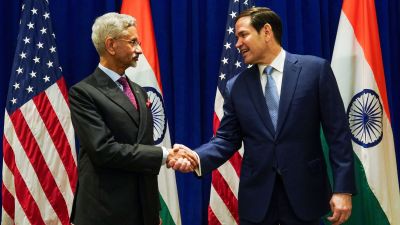Vice President off to Myanmar with goodwill for the Generals
Refusing dialogue with a military dictatorship on its western front, India seems to be busy courting one in the east. Vice-President Bhairon...

Refusing dialogue with a military dictatorship on its western front, India seems to be busy courting one in the east. Vice-President Bhairon Singh Shekhawat flies out on Sunday to cement ties with the Myanmar junta, the highest-level visit since former Prime Minister Rajiv Gandhi travelled there in 1988.
Shekhawat’s November 2-5 visit will take him to Yangon, the ancient kingdom of the Burmans in Bagan and the Glass Palace city of Mandalay: it’s an itinerary that may be the envy of many a leader in Beijing. Shekhawat will meet the all-powerful head of the SPDC Than Shwe and will be feted at a banquet by the Yangon’s second most powerful man, Gen Maung Aye.
Shekhawat will unveil a bust of the apostle of non-violence Mahatma Gandhi in the heart of Yangon university. Besides a gift of some software programmes and books, two agreements on education exchanges and on visa exemption for diplomatic personnel will be signed by the two Foreign Secretaries.
The V-P’s visit, analysts point out, is part of a diplomatic offensive that is geared to tell South-East Asia that India is as much an interested and willing player in the region as China has been for the past few decades. Beijing’s close alliance with Myanmar has been a fact at least since 1962 when Yangon switched the lights under a hardline military regime.
Beijing’s influence remains central 50 years later — witness its intention to build a network of roads that connect with inland waterways on the Irrawaddy, from its border in Yunnan province to the Bay of Bengal — but with one, recent difference. New Delhi’s overt interest in Yangon’s military regime has meant that the SPDC has still not given China the green signal for this ambitious project.
‘‘It is in Myanmar that India and China are competing for attention,’’ analysts here say, adding, ‘‘the tools here are economics, not ideology.’’ India’s diplomatic offensive on its eastern chessboard began with PM Vajpayee’s visit to China in June. It was followed by a tour of Indonesia (where a framework agreement on a free trade regime with the Asean was signed) and Thailand last month.
At home, there was a trip to Nagaland last week. Analysts say that until Deng Xiaoping took up the reins in Beijing in 1979, China covertly funded and trained many an anti-Indian insurgent group in the North-East.
In fact, it was in Bali, Indonesia, that External Affairs minister Yashwant Sinha invited his counterparts from Myanmar and Thailand to a meeting in December in New Delhi, to resurrect the East-West highway that has the potential of linking India’s north-east (from Moreh-Tamu-Kalymyo-Kalewa, across Myanmar, connecting Kanchenaburi in Thailand) with South-East Asia.
Meanwhile, Shekhawat is likely to push for a North-South highway along the Kaladan river that weaves in and out of Mizoram and Myanmar, ending in Sittwe, a deep-water port in southern Myanmar. RITES has already done a detailed project report of this highway. When it is completed, it will enable North East India to break out of its geographical confines and gain access to the sea.
According to New Delhi, Myanmar has occupied a key position on this chessboard at least for the last decade. Even as it toyed with supporting the pro-democracy group of Aung San Suu Kyi — even awarding her the Nehru peace prize in 1995 — it threw in its lot with the military regime after Yangon ‘‘closely co-operated’’ with the Army in operations against North-East insurgent bases across the border.
Besides connectivity, New Delhi is also keen on tapping the oil and gas resources in Myanmar. ONGC Videsh and GAIL have already picked up 20 per cent and 10 per cent participating interest respectively in one of the blocks off the Rakhine coast in Myanmar. A Petroleum Ministry team also visted the country in April to examine commercial on-shore possibilities.
Yangon, on its part, has proposed a hydro-electric project on the Chindwin river at Tamanthi. Officials say the National Hydroelectric Power Corporation is carrying out pre-feasibility studies and if it materialises, a 700 MW capcity station could come up. The idea, officials say, is to develop the area along the Indo-Myanmar border, large parts of which are inaccessible and underdeveloped. These initiatives could mean that North-East insurgent groups will find it difficult to find safe havens in these areas.
(with Pranab Dhal Samanta)
Photos


- 01
- 02
- 03
- 04
- 05





























